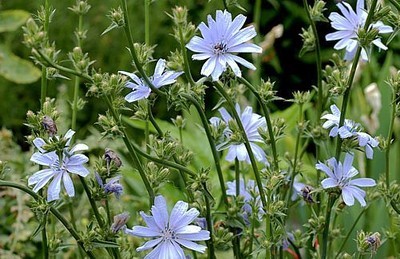
Common Name: Kasni
English Name: Chicory, Indian Endive
Botanical Name: Cichorium intybus Linn.
Family: Compositae, Asteraceae
Description: Chicory is a perennial plant. Rhizome is light yellow outside, white from within, containing milky, bitter juice. Chicory radix is used best during autumn. During that period it has the highest level of inulin.
Chemical Constituents: The flowers of chicory contain saccharides, methoxycoumarin cichorine, flavonoids, essential oils, and anthocyanins.
Properties: Used for the treatment of inflammations and can be applied over swellings. They are also used for the treatment of headaches and provide relief from arthritic pains and swellings. Chicory roots are found to be beneficial for women suffering from premenstrual syndrome (PMS). It helps by maintaining a balance in the hormone level of the body and alleviating the symptoms associated with the condition. Two fibers, raftilin inulin and raftilose oligofructose, present in the herb are fermented by the bacteria in the large intestine, increasing the body’s ability to absorb calcium and certain other minerals. Therapeutically, the herb is very important for the proper functioning of the urinary system, as it helps to detoxify and cleanse the urinary tract. This plant is extensively used in liver disorders.
Used in the following MATXIN product: